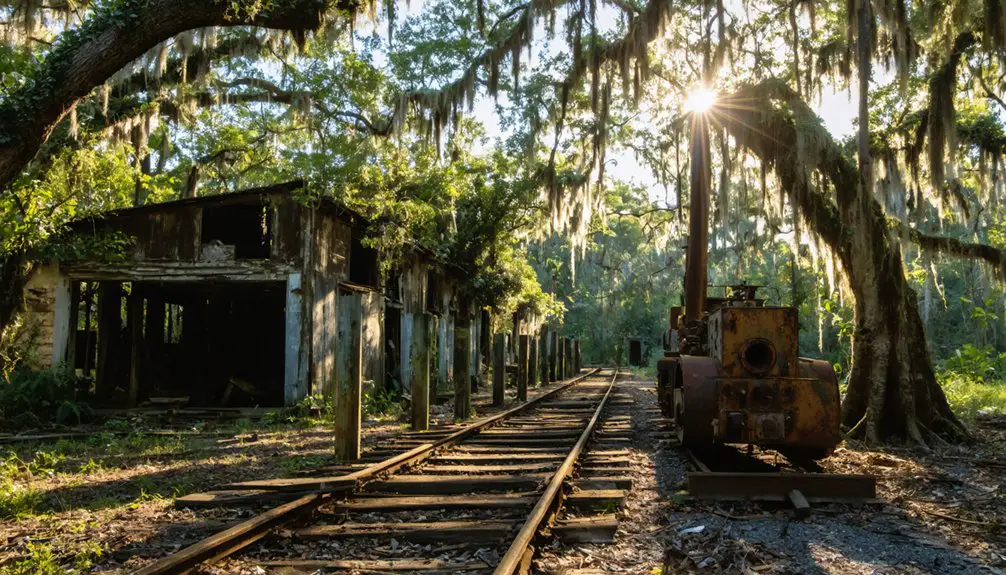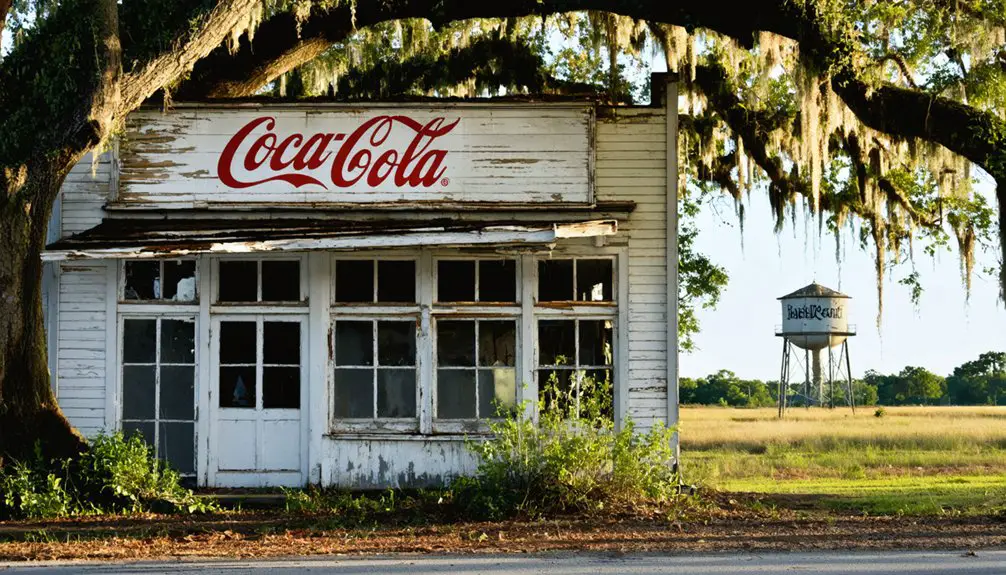You’ll find Juliette’s ghost town remains near Rainbow Springs State Park, where it began as an 1850s cotton settlement before becoming a bustling phosphate mining hub. The town featured general stores, a hotel, and the Cedar Grove Methodist Church, thriving around the Florida Railroad depot until mining’s decline. Today, nature reclaims the abandoned settlement, with only scattered traces hinting at its once-prosperous past. The untold stories of Juliette’s rise and fall reveal fascinating insights into Florida’s pioneering spirit.
Key Takeaways
- Juliette began as a thriving cotton and timber shipping point in the 1850s near Blue Springs, centered around the Florida Railroad.
- The town’s economy transitioned from agriculture to phosphate mining, which ultimately led to its eventual decline and abandonment.
- The closure of Juliette’s post office in 1926 marked a significant turning point, signaling the community’s gradual transformation into a ghost town.
- Physical remnants of Juliette are minimal, with nature reclaiming the former settlement near present-day Rainbow Springs State Park.
- Despite its abandonment, Juliette exemplifies Florida’s boom-and-bust cycle and preserves stories of 19th-century pioneer life and economic transformation.
The Birth of a Cotton Town (1850s)
While many Florida settlements emerged around military outposts or trading routes, Juliette’s story began in the 1850s with Captain Samuel Agnew‘s ambitious cotton venture.
You’ll find the roots of this settlement traced to his strategic decision to clear hundreds of acres near Blue Springs, where he established extensive sea island cotton cultivation.
Unlike densely packed towns of the era, Juliette took shape as a scattered collection of farms around the springs.
The agricultural impact of Agnew’s initiative proved significant, as his cotton fields laid the economic foundation for what would become a thriving community.
You can imagine the transformation of the natural landscape as farmers followed Agnew’s lead, adapting their agricultural practices to the warm Florida climate and establishing the area’s first permanent settlement pattern.
The railroad depot became a vital hub for the growing community, connecting local farmers to broader markets.
The community’s importance grew until it was officially incorporated in 1883, marking its evolution from a rural farming settlement into an established town.
Railroads and Early Development
As the Florida Railroad carved its path across the state in the late 1850s, Juliette’s transformation from a scattered farming settlement into a structured town began to take shape. Slave labor constructed the rail line through challenging terrain, including swamps and dense forests.
The railroad expansion brought more than just steel rails – it delivered the promise of connection and commerce. These developments mirrored the Industrial Revolution’s impact on Florida’s economic landscape. You’d have seen the town’s landscape change as the depot emerged, becoming the heartbeat of local trade and transportation evolution.
The railway didn’t just lay tracks – it wove together communities, transforming quiet crossroads into vibrant centers of progress and possibility.
Around the depot, you’d have found a bustling community taking root. A hotel rose to shelter travelers, while general stores and a post office served both locals and visitors.
The railroad turned Juliette into a crucial shipping point for timber and cotton, linking local farmers and merchants to broader markets they couldn’t reach before.
Daily Life in Historic Juliette
You’d find Juliette’s early residents gathering at three bustling general stores, the hotel near Blue Springs, and the post office – places where business and socializing merged seamlessly.
Your typical day might involve tending sea cotton fields or working at local sawmills, before heading to the railroad depot to ship goods or collect supplies.
If you lived in one of the scattered farmsteads, you’d make regular trips into these community hubs not just for necessities, but to maintain essential social connections in this rural settlement. Many farmers would transport their daily records and cotton transactions to store in the massive steel safe at the manager’s house. The town’s economy later expanded when phosphate mining brought new jobs and opportunities to the area.
Community Gathering Places
During Juliette’s heyday, the town’s social fabric was woven through diverse gathering places that shaped daily life and fostered community bonds.
You’d find locals congregating at three bustling general stores, where they’d share news and barter goods, while the hotel near the springs served as a vibrant meeting spot for travelers and residents alike. Like the Orange Grove House in Zion, the hotel was a crucial refuge for weary visitors.
The Cedar Grove Methodist Church wasn’t just a place of worship – it hosted weddings, community celebrations, and social interactions that strengthened neighborhood ties. The original church tragically burned down in 1935, but the community’s dedication was evident when they rebuilt in 1936.
At the railroad depot, you could catch up on the latest happenings as trains arrived, while the natural splendor of Rainbow Springs provided a scenic backdrop for leisure activities.
The post office, operating until 1926, kept everyone connected through mail and informal chats.
Work and Family
Life in historic Juliette revolved around hard work and tight-knit family bonds, extending beyond the town’s communal gathering spots into the daily routines of its industrious residents.
Social gatherings and church events fostered community spirit and camaraderie among residents.
The family dynamics centered on labor contributions from every member, with diverse occupations shaping daily life:
- You’d find men working the sea cotton fields pioneered by Captain Agnew, managing timber at the sawmills, or later changing to phosphate mining.
- Women maintained households while often helping with small-scale farming, ensuring family survival through domestic skills.
- Children learned responsibility early, pitching in with age-appropriate tasks from field work to household chores.
Neighbors supported each other through shared labor during harvests, creating a resilient community that adapted as Juliette evolved from agricultural roots to mining opportunities.
The Romeo & Juliette Connection
While the ghost town‘s name might suggest a connection to Shakespeare’s famous lovers, Juliette’s relationship with nearby Romeo, Florida actually intersects with the state’s modern “Romeo and Juliet Law” enacted in 2007.
You’ll find that Romeo’s law aims to protect young couples in consensual relationships from lifelong sex offender registration, while Juliette’s legacy represents a different kind of protection – that of historical preservation.
The law’s presence in this region creates an ironic parallel to the town names, as both Romeo and Juliette, Florida serve as reminders of how times change. The law requires the victim be 14 or older for protection under its provisions.
While the ghost town stands frozen in time, the modern law acknowledges evolving social perspectives by providing legal relief to young people within four years of age who face harsh consequences for consensual relationships.
Economic Boom and Industries

As the 1850s ushered in new settlement around Blue Springs, Captain Samuel Agnew’s extensive cotton cultivation marked the beginning of Juliette’s economic story.
The early economy thrived on diverse agriculture, with farmers growing sea cotton, citrus, and tobacco while raising livestock. You’d find three general stores, a sawmill, and a railroad depot supporting the rural community’s needs.
The landscape dramatically changed when phosphate mining emerged as the dominant industry, leading to:
- Local farmers abandoning their fields for mining jobs
- Agricultural decline as labor shifted to the mines
- A boom-bust cycle typical of Florida’s extractive industries
While Blue Springs attracted some tourism with its hotel, the community couldn’t sustain its economic diversity, ultimately succumbing to the mining industry’s powerful but temporary influence.
The Path to Abandonment
The steady decline of Juliette began in the late 19th century when local farmers traded their plows for pickaxes in the phosphate mines. While this shift initially brought prosperity, it ultimately became one of the primary abandonment reasons for the town’s demise.
You’ll find that several factors accelerated the population decline. The closure of the post office in 1926 marked a turning point, followed by the reduced use of the railroad that once connected the community.
Environmental damage from mining, coupled with depleted phosphate reserves, left fewer job opportunities. The town’s isolation between Dunnellon and Romeo proved challenging, especially as younger residents sought opportunities in Florida’s growing urban centers.
Modern-Day Ghost Town Legacy

Today’s visitor to Juliette will find nature reclaiming what remains of this once-bustling Florida settlement.
While the town’s physical structures have largely vanished, its cultural significance lives on through local storytelling and historical documentation.
You’ll discover a ghost town that represents Florida’s boom-and-bust cycles, offering a window into pioneer life and 19th-century economic shifts.
The preservation challenges facing Juliette’s legacy include:
- Natural overgrowth threatening remaining physical traces
- Lack of formal preservation programs or heritage site designations
- Increasing development pressure in surrounding areas
Despite these challenges, Juliette’s untouched state near Rainbow Springs State Park provides an authentic glimpse into Florida’s past.
You won’t find tourist facilities or reconstructed buildings here – just the quiet dignity of a forgotten town slowly returning to nature.
Frequently Asked Questions
Are There Any Remaining Structures or Ruins Still Visible in Juliette Today?
You won’t find any remaining structures or visible ruins in this location today – everything has completely vanished. The once-bustling community has returned to its natural state, leaving no trace behind.
What Happened to the Original Residents When They Left Juliette?
Over 90% of residents dispersed across Marion County when economic decline hit. You’ll find they relocated mainly to phosphate mining towns or nearby Perrine, pursuing jobs that replaced their farming livelihoods.
Were There Any Notable Crimes or Tragic Events in Juliette’s History?
You won’t find documented major crimes or tragic events in the town’s history. The crime history is especially sparse, with local legends focused more on economic decline than actual tragedies.
Did Native Americans Inhabit the Area Before Juliette Was Established?
Like footprints in time, Native tribes – particularly the Timucua and Apalachee peoples – thrived in this area for thousands of years before Juliette’s establishment, leaving behind shell mounds and archaeological treasures.
What Was the Peak Population of Juliette During Its Most Prosperous Years?
You’ll find this ghost town reached between 200-500 residents during its late 1800s peak, though exact numbers aren’t documented. The population decline started in the 1920s before complete abandonment.
References
- https://travelmadepersonal.com/juliette-ghost-town-florida/
- https://www.youtube.com/watch?v=8oxNalj9NE0
- https://www.ocalastyle.com/ghost-towns-of-marion-county/
- https://www.ghosttowns.com/states/fl/juliette.html
- https://www.youtube.com/shorts/zvaQq31WWrs
- https://en.wikipedia.org/wiki/History_of_Savannah
- https://study.com/academy/lesson/florida-railroad-history.html
- https://www.frrm.org/zerfas1/
- https://en.wikipedia.org/wiki/Florida_Railroad
- https://en.wikipedia.org/wiki/Julia_Tuttle



